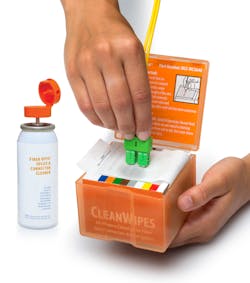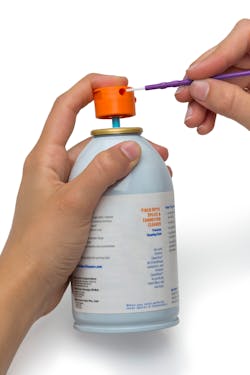Wet-to-dry fiber cleaning: A good way to ensure network reliability
By Jay Tourigny, MicroCare LLC
Expert opinions vary, but many agree that up to 75% of all fiber network problems are caused by contamination of patch cords, adapters, alignment sleeves or transceivers. Dirty endface connectors in particular are a real hazard to modern fiber-optic networks. The higher the light frequency in a network, the greater its sensitivity to contamination. This means that faster 5G networks, which need every milliwatt of power to function flawlessly, are more vulnerable to contamination. Although endface contamination is typically just microns in size, and only visible when magnified with an inspection scope, it can still cause serious performance and reliability problems for a network.
Two common contaminants
Two main types of endface contamination are dust and oil residue. Dust comes from various environmental sources. These can include things like skin flakes and stray hair from installers or dirt from dusty work sites. It also comes from other, less obvious sources. For instance, dust often generates through the contact friction between plastic connectors as they are mated. Dust can even come from the fiber cleaning tools themselves. Examples include lint from paper-type wipes and foam particles from foam-tipped cleaning sticks.
Static often makes dust contamination worse. An electrostatic charge on a connector attracts airborne particulate and locks it onto the connector endface. The condition is worsened in dry, low-humidity conditions such as winter cold or desert heat. Electrostatically charged particles are often created by test equipment, cooling fans on network gear or by an internal HVAC system. These charges, also known as triboelectric effect, remain on the ferrule surface and turns the contact area of the endface into a magnet, attracting dust right to the center of the endface where it will do the most damage.
Any dust residing on the sleeve gets pushed into the contact zone as the connector pair is mated. The dust breaks apart and grinds into the ceramic and glass ferrules with an approximately 15,000-psi force in the contact zone. This can cause permanent scratches and pits in the center core, or contact zone, of both termini endfaces. If the damage is severe enough, it may require reterminating or replacing the cables altogether.
Oil and other residues
Oil-based contamination and other residues come from many sources. The most common are fingerprints and skin oil. However, other residues also contribute to endface contamination. These include things like plasticizer off-gassing from PVC plastic connector endcaps, coastal salt for and isopropyl alcohol (IPA). IPA is commonly used for fiber cleaning; however, IPA is hygroscopic. It absorbs water and minerals from the atmosphere, which redeposit onto the fiber endfaces.
Signal interference
A microscopic dust particle, a residue from an accidental finger touch, or even the outgassing from the removal of a dustcap can interfere with the network’s light path as it passes between two mated fibers. When the light is blocked, or the direction of the light changes, a phenomenon known as chromatic aberration exists.
Contamination blocking the light signal’s path can cause absorption loss. Or it may change the light’s index of refraction, or disperse the signal’s wavelength unpredictably, causing insertion loss. Dust or oil contamination could also cause light to be directed back into the fiber to its original source, also known as back reflection. In all of these instances, the light signal weakens, slows down the network speed or results in unacceptable data transmission losses—especially for those networks with angled-polish connectors. And if the refraction angle is altered enough, the network signal may be lost altogether, requiring an expensive and disruptive emergency rollback to troubleshoot and repair the problem. So, cleaning all connection points becomes vitally important; and wet-to-dry cleaning is an effective way to get that done.
How wet-to-dry cleaning works
One of the most common ways contaminate draws to a fiber endface is from wiping the endface with a dry wipe, dry clicker tool or a dry stick. The wiping action creates a triboelectric charge that attracts unwanted airborne contaminants to the connector face. This static buildup is especially intensified in low-humidity environments.
Dust clings to both the outer regions of the connector and at the ferrule apex in the contact zone. Most fiber endfaces are made of nonconductive materials such as plastic, ceramic, glass and epoxies so the static charge doesn’t have a path to ground and the charge cannot discharge. The dust particles stay electrically bonded to a cable endface until the static charge finds a conductive path for it to dissipate.
Wet-to-dry cleaning using a fiber-optic cleaning fluid provides a solution. The wet cleaning fluid serves as a dissipative medium. It adds humidity to the endfaces, breaks the static bond and allows the fiber cleaning tools to do a better job. The fluid temporarily creates a conductive path for the static to disperse, making it easier to physically remove the contaminant with a wipe, cleaning stick or mechanical clicker tool.
Wet-to-dry cleaning with a wipe
Always use a high-quality optical-grade wipe for wet-to-dry cleaning. Use one that will not lint, shred or leave debris behind. During the wet-to-dry cleaning process, an installer uses a section of an optical-grade cleaning wipe, dampened with a static-dissipative cleaning fluid. The installer then wipes the connector endface starting at the damp area of the wipe and moving in one direction toward the dry area of the cleaning wipe. This removes the contamination and minimizes the static charge in one step.
Some suppliers offer wipes in special packaging engineered to minimize static charges as individual wipes are dispensed. Also, leaving the wipes in the packaging until ready to use ensures they stay clean, preventing waste. Wipes should be used only once and then thrown away to prevent cross-contamination on other network endfaces.
Wet-to-dry cleaning with a cleaning stick
For best results use a polymer-tipped cleaning stick. Avoid those with a paper or foam tip. They typically fall apart, leaving lint and foam particles behind. Cleaning sticks are ideal for use on heavily soiled connectors or for cleaning in hard-to-reach alignment sleeves. For wet-to-dry cleaning with a stick, the installer moistens the cleaning stick with a cleaning fluid first, being careful not to oversaturate the tip. After inserting the stick into the connector, they rotate the stick about six times in the same direction. They avoid extreme force and do not excessively scrub the endface to prevent scratching, pitting or scarring the endfaces.The combination of the cleaning fluid plus the stick breaks up the contamination and eliminates electrostatic charge. When cleaning jacks, the stick covers a large cleaning area. This prevents particle migration to the core. The stick also makes incidental contact with the alignment sleeve and pulls off dust from the jack’s sidewalls. When plug cleaning, the stick gets all the way to the ferrule edge and chamfer, just below the edge, for thorough cleaning.
Cleaning sticks should always be kept in their package until ready to use to prevent soiling or damage. Also, cleaning sticks are single-use. Reusing the same stick spreads contamination from one endface to the other.
Wet-to-dry cleaning with a mechanical clicker tool
Clicker tools work well for rapid cleaning of lighter levels of contamination. To use the wet-to-dry method, the installer first applies a small dab of cleaning fluid to an optical-grade wipe. They do not apply fluid directly to the clicker tool. The installer then presses the tip of the mechanical clicker tool into the moistened section of wipe. Then they insert the clicker tool into the endface for quick, one-click cleaning.
The wet in wet-to-dry cleaning
Some fiber installers use IPA to clean fiber endfaces. However, IPA is hygroscopic, meaning it absorbs moisture out of the air. As the IPA absorbs the moisture, it also picks up airborne microscopic dust particles such as from traffic exhaust, plant pollen, construction dust and minerals and salts from the air.
An optical-grade cleaning fluid that is engineered specifically for cleaning fiber-optic endfaces is the best choice when wet-to-dry fiber cleaning. The cleaning fluid should be ultra-pure, residue-free and nonflammable. It should also be in a hermetically sealed (un-refillable) container to prevent cross-contamination and spilling. Using a fast-drying, static-dissipative cleaning fluid also eliminates any additional drying step, saving installers time.
Meet the standards for clean
The wet-to-dry cleaning method is recommended by both the Institute of Printed Circuits (IPC) and the International Electronics Manufacturing Initiative (iNEMI) to dissipate static and meet the IPC-8497-1 fiber-optic cleaning standard.
By thoroughly cleaning all network connections to this standard, installers can help their networks perform flawlessly. Cleaning all connectors prior to startup helps ensure signal reliability, limits the number of return troubleshooting and repair calls, and provides an overall more robust network. Those looking for help in wet-to-dry cleaning and removing static from their fiber-optic connectors should work with a company that has expertise in fiber-optic cleaning. They can recommend the fluids, tools and methods that work best.
Jay Tourigny is senior vice president at MicroCare LLC, which offers Sticklers brand fiber cleaning solutions. He has been in the industry for more than 30 years, and holds multiple U.S. patents for cleaning-related products that are used daily in fiber-optic, medical and precision cleaning applications.

